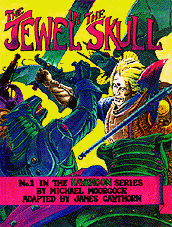| HOME | BOOKS | COMICS | RECORDS | NEWS | PEOPLE | PICTURES | ORDERS | HISTORY | office@savoy.abel.co.uk |
|
|
The Jewel in the Skull by Michael Moorcock (OUT OF PRINT) 1978 ISBN 0 86130 006 8 80pp Art / Story adaptation—James Cawthorn |
|
|
|
| A graphic novel before there were any (UK-originated ones), modelled
on the American edition of Jungle Tales of Tarzan by Burne Hogarth. The first in Savoy's large format adaptations of Michael Moorcock's Dorian Hawkmoon 'Runestaff' books, co-published by Savoy and Peter Ledeboer's 'Big O' imprint (the distribution arm of '60s underground mag OZ), with in-depth Cawthorn interview by David Britton. Cawthorn (Mike's preferred artist for his fantasy stuff) and
Moorcock have been a team since their first meeting in the middle
'50s. The latter drew the very first Elric illustration (see the Cawthorn portfolio in the Pictures section), and his artwork-designs often provided visualisation assistance
for characters and scenes in the Hawkmoon novels. A supposedly
pulped very rare mis-printed edition of The Jewel in the Skull, with non-facing double-page artwork, exists.
James Cawthorn's sequel to The Jewel in the Skull is The Crystal and the Amulet. |
| One of the many outstanding scenes from The Jewel in the Skull: Dorian Hawkmoon sails in chains towards the nightmarish Towers of Londra, capital of Granbretan. |
|
|
"In the introduction to Swords of Heaven, Flowers of Hell Moorcock expresses his distaste for the more baroque American styles of comic book art, and judging by Jim Cawthorn's Jewel in the Skull, he may have a point. Cawthorn's book is simultaneously the least elaborate and the most visually effective book discussed here. Instead of focusing on surface decoration, Cawthorn has attempted to give substance to the stone, metal and flesh of this world, and he has succeeded. The problem is, as with Brunner, in the narrative. More than anything else, Jewel looks like one of those profusely illustrated 19th century novels with the text removed. This can be traced to inexperience (this being Cawthorn's first extended comic work) or to trying to follow the original story too closely. But when it starts to move, as in the battle scenes, the effect is stunning. Recommended, provided you've read the book first. Practically all of the artists and writers mentioned here could have pulled it off if given a chance to develop it, and Cawthorn may make it yet. Until that fine day, rest assured that the Champion Eternal shall continue to roam the bookstalls, fighting Chaos, restoring the balance, asking for directions to Tanelorn, and picking up royalty cheques." THE COMICS JOURNAL "Jewel in the Skull illustrated by James Cawthorn is truly a really excellent work! Cawthorn has not yet reached his best stride and dimension in his work, but there is a quality here that is most compelling and fascinating. He has gone far beyond any of the existing fantasy interpretations of the cartoon heroics one finds in most book material today. He has reached a point of the unpredictable in his characterisations, his mood, his strange atmosphere and gross, brutal intensity. One almost feels a quality of the bizarre, dark, forbidding quality first shown in certain classic Russian movies (of the war genre) like Alexander Nevsky by Eisenstein—the Teutonic Knights, for example, and the battle on the ice. There is something of a crude power here—which disavows the matinee idol posturing in cliché assumptions of most vapid styles of Marvel Comics. I'm impressed by the gargoyle quality of the masks, the helms(?), the garb(?), the uncharacteristic settings. Perhaps if Cawthorn were to experiment with a brush instead of pen work, his drawing would begin to get the tragic density his power is searching for. But he has an authentic talent and I'm happy to see this opus—and anticipate the next. He's on the threshold of big things!" BURNE HOGARTH Savoy note: No living comic artist has so successfully assimilated the myriad art schools of the 20th Century—German Expressionism, Surrealism, Art Nouveau and moulded them into a unique composite graphic form, as Burne Hogarth. His Jungle Tales of Tarzan, is THE definitive comic strip. In both this and its prequel, Tarzan of the Apes, Hogarth proved that the comic form—"the most despised of mediums"—could be transcended. Mr Hogarth, who has always struggled to assert his belief in certain strongly-held values over the cynicism and imaginative poverty to be found in his field, wrote Savoy a long letter, part of which formed the critical review of James Cawthorn's "pictorial fiction" adaptation printed above. His comments are supplied in full. |
| Main Comics Page | Lord Horror | Meng & Ecker | Other Comics | Articles | The Reverbstorm Appendix | Links |

